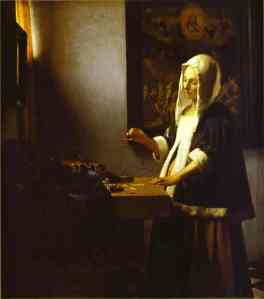Woman Weighing Pearls (1662 – 1665) by Jan Vermeer is also commonly referred to as, Woman Holding a Balance. This oil painting was produced in Delft, Holland; the small town from which Vermeer originated.
Woman Weighing Pearls is quite possibly Vermeer’s most successful composition. In no other piece does his composition so effectively compliment the emotional setting and theme of his work. The light against dark, mass against void, the interaction of verticals and horizontals against diagonals, and the extensive yet discreet geometry, create a balanced yet subtly dynamic work.
Vermeer’s Woman Weighing Pearls bears a strong resemblance to Pieter de Hooch’s Woman Weighing Gold, but since neither piece is dated it remains uncertain as to who inspired whom.
At first glance, the woman posing in Woman Weighing Pearls appears to be with child, but it was very uncommon during this era to portray a pregnant woman in art. Even in the religious works where representations of pregnant women were required draperies concealed their bodies and pregnancies. One explanation is that the bulky silhouette was an encouraged characteristic of Dutch fashion in the mid-17th century.
Woman Weighing Pearls has multiple interpretations proposed by numerous critics. Some of the interpreters believe that the woman portrayed was with child, while others foster the thought that it was simply the style of the time.
One scholar argues that the woman was portrayed as the image of a pregnant Virgin Mary and that her action of contemplating the balanced scales was an anticipation of Christ’s life, sacrifice, and eventual foundation of the Catholic Church.
A similar pictorial idea revolves around the thought that the woman is a secularized image of the Virgin Mary, who, standing before the Last Judgment, adopts the part of compassionate mother and intercessor.
One scholar, Arthur Wheelock notes the mood of sincere serenity within Woman Weighing Pearls and concludes that, “”the essential message is that one should conduct one’s life with temperance and balanced judgment. Indeed this message, with or without its explicit religious context, appears in paintings from all phases of Vermeer’s career and must, therefore, represent one of his fundamental beliefs. The balance, an emblem of Justice, and eventually of the final judgment; denotes the woman’s responsibility to weigh and balance her own action.”
Another scholar theorizes that the picture within Woman Weighing Pearls, The Last Judgment, was to be viewed a warning. Meaning, the woman should not focus her attention by weighing earthly goods and should concentrate on eternal values.
Woman Weighing Pearls was influenced by the rise of the merchant class during the Golden Age of Dutch Art. The traditional patrons of the arts, the church and monarchy were substituted in the Netherlands by the growing middle class. At this time, new categories of paintings quickly evolved. Genre paintings, landscapes, seascapes, and still-life works, were in high-demand as they surpassed the traditional historical paintings that had been produced for the higher classes. Woman Weighing Pearls is a genre scene. The woman is participating in an act of everyday life. The genre scene allows for the personal drama of the subject matter to unfold to the viewer.
I found this piece to be aesthetically appealing because of the realism. I appreciated the light shining through the window and delicately illuminating the woman’s face. I was also drawn to the peaceful presence the image proposes. It is simply a beautiful piece that possesses a hidden story open for interpretation.
Works Cited:
http://www.essentialvermeer.com/catalogue/woman_holding_a_balance.html
